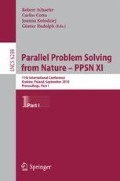Abstract
The game of Go has attracted much attention from the artificial intelligence community. A key feature of Go is that humans begin to learn on a small board, and then incrementally learn advanced strategies on larger boards. While some machine learning methods can also scale the board, they generally only focus on a subset of the board at one time. Neuroevolution algorithms particularly struggle with scalable Go because they are often directly encoded (i.e. a single gene maps to a single connection in the network). Thus this paper applies an indirect encoding to the problem of scalable Go that can evolve a solution to 5×5 Go and then extrapolate that solution to 7×7 Go and continue evolution. The scalable method is demonstrated to learn faster and ultimately discover better strategies than the same method trained on 7×7 Go directly from the start.
Access this chapter
Tax calculation will be finalised at checkout
Purchases are for personal use only
Preview
Unable to display preview. Download preview PDF.
References
Burmeister, J., Wiles, J.: The challenge of Go as a domain for AI research: A comparison between go and chess. In: Proceedings of the Third Australian and New Zealand Conference on Intelligent Information Systems. IEEE Western Australia Section, pp. 181–186 (1995)
Silver, D., Sutton, R., Müller, M.: Reinforcement learning of local shape in the game of go. In: 20th International Joint Conference on Artificial Intelligence, pp. 1053–1058 (2007)
Schaul, T., Schmidhuber, J.: Scalable neural networks for board games. In: Proceedings of the International Conference on Artificial Neural Networks (ICANN). Springer, Heidelberg (2008)
Stanley, K.O., Miikkulainen, R.: Evolving a roving eye for Go. In: Deb, K., et al. (eds.) GECCO 2004. LNCS, vol. 3103, pp. 1226–1238. Springer, Heidelberg (2004)
Botermans, J.: The Book of Games: Strategy, Tactics, and History. Sterling Publishing Co. (2008)
Shotwell, P.: Go! More Than a Game. Turtle Publishing (2003)
Silver, D., Sutton, R.S., Müller, M.: Sample-based learning and search with permanent and transient memories. In: Proceedings of the 25th International Conference on Machine Learning, pp. 968–975. ACM, New York (2008)
Enzenberger, M.: Evaluation in Go by a neural network using soft segmentation. In: Advances in Computer Games: Many Games, Many Challenges: Proceedings of the ICGA/IFIP SG16 10th Advances in Computer Games Conference (ACG 10), Graz, Styria, Austria, November 24-27, p. 97. Kluwer Academic Pub., Dordrecht (2003)
Schraudolph, N.N., Dayan, P., Sejnowski, T.J.: Temporal difference learning of position evaluation in the game of Go. In: Advances in Neural Information Processing Systems, pp. 817–817 (1994)
Graves, A., Fernandez, S., Schmidhuber, J.: Multi-dimensional recurrent neural networks. In: de Sá, J.M., Alexandre, L.A., Duch, W., Mandic, D.P. (eds.) ICANN 2007. LNCS, vol. 4668, pp. 549–558. Springer, Heidelberg (2007)
Yao, X.: Evolving artificial neural networks. Proceedings of the IEEE 87(9), 1423–1447 (1999)
Stanley, K.O., Miikkulainen, R.: Evolving neural networks through augmenting topologies. Evolutionary Computation 10, 99–127 (2002)
Stanley, K.O., Miikkulainen, R.: Continual coevolution through complexification. In: Genetic and Evolutionary Computation Conference (2002)
Fogel, D.B.: Blondie24: Playing at the Edge of AI (2002)
Stanley, K.O., D’Ambrosio, D.B., Gauci, J.: A hypercube-based indirect encoding for evolving large-scale neural networks. Artificial Life 15(2), 185–212 (2009)
Hornby, G.S., Pollack, J.B.: Creating high-level components with a generative representation for body-brain evolution. Artificial Life 8(3) (2002)
Bongard, J.C.: Evolving modular genetic regulatory networks. In: Proceedings of the 2002 Congress on Evolutionary Computation (2002)
Stanley, K.O., Miikkulainen, R.: A taxonomy for artificial embryogeny. Artificial Life 9(2), 93–130 (2003)
Stanley, K.O.: Compositional pattern producing networks: A novel abstraction of development. Genetic Programming and Evolvable Machines Special Issue on Developmental Systems 8(2), 131–162 (2007)
Gauci, J., Stanley, K.O.: A case study on the critical role of geometric regularity in machine learning. In: Proceedings of the Twenty-Third AAAI Conference on Artificial Intelligence (AAAI-2008). AAAI Press, Menlo Park (2008)
Gauci, J., Stanley, K.O.: Autonomous evolution of topographic regularities in artificial neural networks. Neural Computation 22(7), 1860–1898 (2010)
Enzenberger, M., Müller, M.: Fuego–an open-source framework for board games and go engine based on monte-carlo tree search. Technical report, Technical Report TR09-08, University of Alberta, Edmonton (2009)
Gelly, S., Silver, D.: Combining online and offline knowledge in uct. In: Ghahramani, Z. (ed.) Proceedings of the International Conference of Machine Learning (ICML 2007), pp. 273–280 (2007)
Author information
Authors and Affiliations
Editor information
Editors and Affiliations
Rights and permissions
Copyright information
© 2010 Springer-Verlag Berlin Heidelberg
About this paper
Cite this paper
Gauci, J., Stanley, K.O. (2010). Indirect Encoding of Neural Networks for Scalable Go. In: Schaefer, R., Cotta, C., Kołodziej, J., Rudolph, G. (eds) Parallel Problem Solving from Nature, PPSN XI. PPSN 2010. Lecture Notes in Computer Science, vol 6238. Springer, Berlin, Heidelberg. https://doi.org/10.1007/978-3-642-15844-5_36
Download citation
DOI: https://doi.org/10.1007/978-3-642-15844-5_36
Publisher Name: Springer, Berlin, Heidelberg
Print ISBN: 978-3-642-15843-8
Online ISBN: 978-3-642-15844-5
eBook Packages: Computer ScienceComputer Science (R0)

